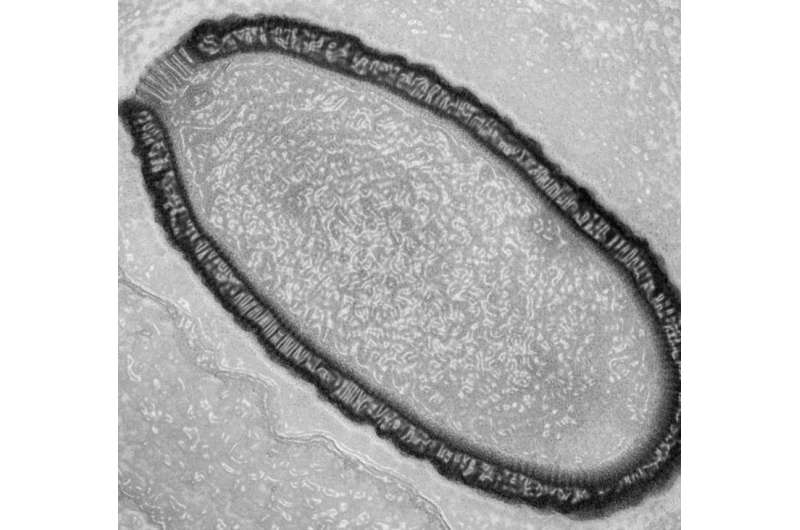Pithovirus particle in an infected Acanthamoeba castellanii cell.
A team of scientists affiliated with several research facilities in France has conducted a study on giant viruses known as mimiviruses and has found that at least some of them have an immune system that is similar in some ways to CRISPR in bacteria. In their paper published in the journal Nature, the team describes the genetic study they undertook of multiple strains of mimiviruses looking to understand why some of them appeared to have immunity to a particular kind of virophage infection while others did not.
Scientists have only known about the existence of mimiviruses and other giant viruses for not much more than a decade, thus research surrounding them is still relatively new. One thing that has been learned is that some of these mammoth sized viruses can be infected by other smaller viruses, known as virophages. Then, just two years ago, it was found that some mimiviruses have immunity against some virophages, and others do not. In this new effort, the researchers believe they have uncovered the reason why that is and the process by which that immunity works.
Suspecting that the mimiviruses were operating in a fashion similar to the way that bacteria ward off viral infections, via CRISPR (where snippets of DNA are stolen from invading viruses for use in identifying them the next time around) the researchers looked at the genomes of 60 strains of mimiviruses, searching for bits of DNA from a virophage known as Zamilon. In so doing, they found their suspicions confirmed, the strains of mimiviruses that were immune to Zamilon all had bits of the virophage residing in their own, which allowed the mimiviruses to recognize the infecting virus and to immediately put up a fight when it was detected. The researchers also found that the mimiviruses they studied had enzymes in them that were able to corrupt DNA that was not its own, which is similar to how CRISPER works in bacteria. The group has dubbed this new type of immune system in mimiviruses, MIMIVIRE.
The findings by the team not only help to better understand mimiviruses, which have been found to infect amoebas, but also fuels the debate regarding whether they should be categorized as an entirely new form of life, or whether they should be classified as being alive at all.
More information: Anthony Levasseur et al. MIMIVIRE is a defence system in mimivirus that confers resistance to virophage, Nature (2016). DOI: 10.1038/nature17146
Journal information: Nature
© 2016 Phys.org























